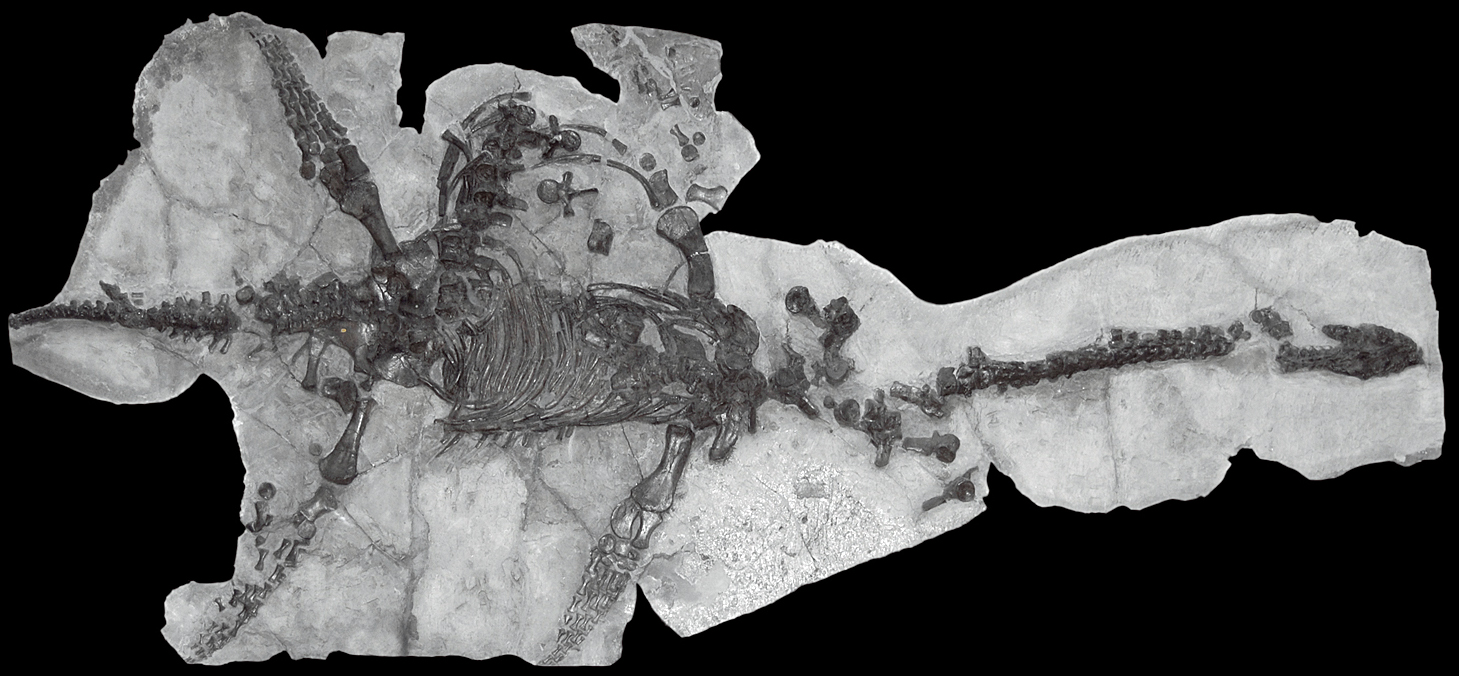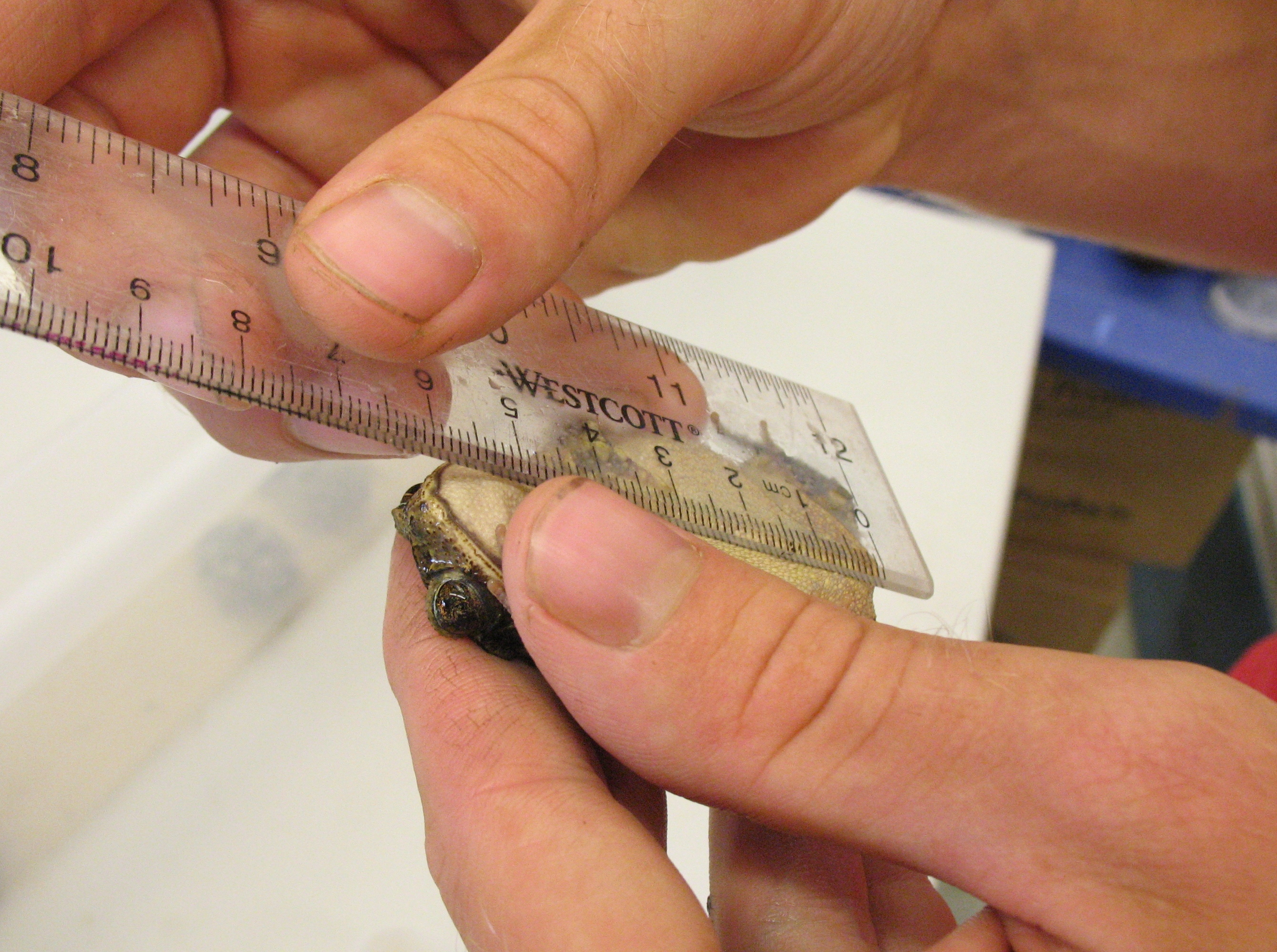|
Keichousaurus BW
''Keichousaurus'' (meaning " Kweichow lizard") is an extinct genus of pachypleurosaurian marine reptile from the Chialingchiang and Falang Formations of China with two known species attributed to the genus: ''K. hui'' and ''K. yuananensis''. ''Keichousaurus'' is among the most common sauropterygian fossils recovered and are often found as nearly complete, articulated skeletons, making them popular among collectors. ''Keichousaurus'', and the pachypleurosaur family broadly, are sometimes classified within Nothosauroidea, but are otherwise listed as a separate, more primitive lineage within Sauropterygia. Discovery and naming The holotype of ''K. hui'', was discovered in the Falang Formation of Guizhou Province, China in 1957 by Hu Chengzhi and was named by Young (1958).C.-C. Young. (1958). On the new Pachypleurosauroidea from Keichow, south-west China. ''Vertebrata PalAsiatica'' 2(2-3):72-81 The second species, ''K. yuananensis'', was discovered in the Chialingchiang F ... [...More Info...] [...Related Items...] OR: [Wikipedia] [Google] [Baidu] |
Early Triassic
The Early Triassic is the first of three epochs of the Triassic Period of the geologic timescale. It spans the time between 251.9 Ma and Ma (million years ago). Rocks from this epoch are collectively known as the Lower Triassic Series, which is a unit in chronostratigraphy. The Early Triassic is the oldest epoch of the Mesozoic Era. It is preceded by the Lopingian Epoch (late Permian, Paleozoic Era) and followed by the Middle Triassic Epoch. The Early Triassic is divided into the Induan and Olenekian ages. The Induan is subdivided into the Griesbachian and Dienerian subages and the Olenekian is subdivided into the Smithian and Spathian subages. The Lower Triassic series is coeval with the Scythian Stage, which is today not included in the official timescales but can be found in older literature. In Europe, most of the Lower Triassic is composed of Buntsandstein, a lithostratigraphic unit of continental red beds. The Early Triassic and partly also the Middle Trias ... [...More Info...] [...Related Items...] OR: [Wikipedia] [Google] [Baidu] |
Sauropterygia
Sauropterygia ("lizard flippers") is an extinct taxon of diverse, aquatic diapsid reptiles that developed from terrestrial ancestors soon after the end-Permian extinction and flourished during the Triassic before all except for the Plesiosauria became extinct at the end of that period. The plesiosaurs would continue to diversify until the end of the Mesozoic, when they became extinct as part of the end-Cretaceous mass extinction. Sauropterygians are united by a radical adaptation of their pectoral girdle, adapted to support powerful flipper strokes. Some later sauropterygians, such as the pliosaurs, developed a similar mechanism in their pelvis. Other than being diapsids, their affinities to other reptiles have long been contentious. Sometimes suggested to be closely related to turtles, other proposals have considered them most closely related to Lepidosauromorpha or Archosauromorpha, and/or the marine reptile groups Thalattosauria and Ichthyosauromorpha. Origins an ... [...More Info...] [...Related Items...] OR: [Wikipedia] [Google] [Baidu] |
Triassic Sauropterygians
The Triassic ( ; sometimes symbolized 🝈) is a geologic period and system which spans 50.5 million years from the end of the Permian Period 251.902 million years ago ( Mya), to the beginning of the Jurassic Period 201.4 Mya. The Triassic is the first and shortest period of the Mesozoic Era and the seventh period of the Phanerozoic Eon. Both the start and end of the period are marked by major extinction events. The Triassic Period is subdivided into three epochs: Early Triassic, Middle Triassic and Late Triassic. The Triassic began in the wake of the Permian–Triassic extinction event, which left the Earth's biosphere impoverished; it was well into the middle of the Triassic before life recovered its former diversity. Three categories of organisms can be distinguished in the Triassic record: survivors from the extinction event, new groups that flourished briefly, and other new groups that went on to dominate the Mesozoic Era. Reptiles, especially archosaurs, were the chief terr ... [...More Info...] [...Related Items...] OR: [Wikipedia] [Google] [Baidu] |
Viviparity
In animals, viviparity is development of the embryo inside the body of the mother, with the maternal circulation providing for the metabolic needs of the embryo's development, until the mother gives birth to a fully or partially developed juvenile that is at least metabolically independent. This is opposed to oviparity, where the embryos develop independently outside the mother in eggs until they are developed enough to break out as hatchlings; and ovoviviparity, where the embryos are developed in eggs that remain carried inside the mother's body until the hatchlings emerge from the mother as juveniles, similar to a live birth. Etymology The term "viviparity" and its adjective form "viviparous" both derive from the Latin ''vivus'', meaning "living"; and ''pario'', meaning "give birth to". Reproductive mode Five modes of reproduction have been differentiated in animals based on relations between zygote and parents. The five include two nonviviparous modes: ovulipari ... [...More Info...] [...Related Items...] OR: [Wikipedia] [Google] [Baidu] |
Piscivorous
A piscivore () is a carnivorous animal that primarily eats fish. Fish were the diet of early tetrapod evolution (via water-bound amphibians during the Devonian period); insectivory came next; then in time, the more terrestrially adapted reptiles and synapsids evolved herbivory. Almost all predatory fish (most sharks, tuna, billfishes, pikes etc.) are obligated piscivores. Some non-piscine aquatic animals, such as whales, sea lions, and crocodilians, are not completely piscivorous; often also preying on invertebrates, marine mammals, waterbirds and even wading land animals in addition to fish, while others, such as the bulldog bat and gharial, are strictly dependent on fish for food. Some creatures, including cnidarians, octopuses, squid, cetaceans, spiders, grizzly bears, jaguars, wolves, snakes, turtles and sea gulls, may have fish as significant if not dominant portions of their diets. Humans can live on fish-based diets, as can their carnivorous domesticated ... [...More Info...] [...Related Items...] OR: [Wikipedia] [Google] [Baidu] |
Keichousaurus Fossil With Scale
''Keichousaurus'' (meaning " Kweichow lizard") is an extinct genus of pachypleurosaurian marine reptile from the Chialingchiang and Falang Formations of China with two known species attributed to the genus: ''K. hui'' and ''K. yuananensis''. ''Keichousaurus'' is among the most common sauropterygian fossils recovered and are often found as nearly complete, articulated skeletons, making them popular among collectors. ''Keichousaurus'', and the pachypleurosaur family broadly, are sometimes classified within Nothosauroidea, but are otherwise listed as a separate, more primitive lineage within Sauropterygia. Discovery and naming The holotype of ''K. hui'', was discovered in the Falang Formation of Guizhou Province, China in 1957 by Hu Chengzhi and was named by Young (1958).C.-C. Young. (1958). On the new Pachypleurosauroidea from Keichow, south-west China. ''Vertebrata PalAsiatica'' 2(2-3):72-81 The second species, ''K. yuananensis'', was discovered in the Chialingchiang F ... [...More Info...] [...Related Items...] OR: [Wikipedia] [Google] [Baidu] |
Allometric
Allometry (Ancient Greek "other", "measurement") is the study of the relationship of body size to shape, anatomy, physiology and behaviour, first outlined by Otto Snell in 1892, by D'Arcy Thompson in 1917 in ''On Growth and Form'' and by Julian Huxley in 1932. Overview Allometry is a well-known study, particularly in statistical shape analysis for its theoretical developments, as well as in biology for practical applications to the differential growth rates of the parts of a living organism's body. One application is in the study of various insect species (e.g., Dynastes, Hercules beetles), where a small change in overall body size can lead to an enormous and disproportionate increase in the dimensions of appendages such as legs, antennae, or horns. The relationship between the two measured quantities is often expressed as a power law equation (allometric equation) which expresses a remarkable scale symmetry: : y = k x^a, or in a logarithmic form, : \log y = a \log x + \l ... [...More Info...] [...Related Items...] OR: [Wikipedia] [Google] [Baidu] |
Dactylosaurus
''Dactylosaurus'' is a genus of nothosaur in the family Pachypleurosauridae. Along with '' Anarosaurus'', ''Dactylosaurus'' was one of the earliest known pachypleurosaurs to come from Europe.Lepidosauromorpha: Pachypleurosauridae: Dactylosaurus & Anarosaurus Palaeos.com. Last accessed 2008-07-04. Etymology ''Dactylosaurus'' comes from the ' (), "" and ' (), meaning "" or ...[...More Info...] [...Related Items...] OR: [Wikipedia] [Google] [Baidu] |
Keichousaurus Hui Sexual Dimorphism
''Keichousaurus'' (meaning " Kweichow lizard") is an extinct genus of pachypleurosaurian marine reptile from the Chialingchiang and Falang Formations of China with two known species attributed to the genus: ''K. hui'' and ''K. yuananensis''. ''Keichousaurus'' is among the most common sauropterygian fossils recovered and are often found as nearly complete, articulated skeletons, making them popular among collectors. ''Keichousaurus'', and the pachypleurosaur family broadly, are sometimes classified within Nothosauroidea, but are otherwise listed as a separate, more primitive lineage within Sauropterygia. Discovery and naming The holotype of ''K. hui'', was discovered in the Falang Formation of Guizhou Province, China in 1957 by Hu Chengzhi and was named by Young (1958).C.-C. Young. (1958). On the new Pachypleurosauroidea from Keichow, south-west China. ''Vertebrata PalAsiatica'' 2(2-3):72-81 The second species, ''K. yuananensis'', was discovered in the Chialingchiang Fo ... [...More Info...] [...Related Items...] OR: [Wikipedia] [Google] [Baidu] |
Snout–vent Length
Snout–vent length (SVL) is a morphometric measurement taken in herpetology from the tip of the snout to the most posterior opening of the cloacal slit (vent)."direct line distance from tip of snout to posterior margin of vent" It is the most common measurement taken in herpetology, being used for all amphibians, lepidosaurs, and crocodilia Crocodilia () is an order of semiaquatic, predatory reptiles that are known as crocodilians. They first appeared during the Late Cretaceous and are the closest living relatives of birds. Crocodilians are a type of crocodylomorph pseudosuchia ...ns (for turtles, carapace length (CL) and plastral length (PL) are used instead). The SVL differs depending on whether the animal is struggling or relaxed (if alive), or various other factors if it is a preserved specimen. For fossils, an osteological correlate such as precaudal length must be used. When combined with weight and body condition, SVL can help deduce age and sex. Advantag ... [...More Info...] [...Related Items...] OR: [Wikipedia] [Google] [Baidu] |
Sexual Maturity
Sexual maturity is the capability of an organism to reproduce. In humans, it is related to both puberty and adulthood. ''Puberty'' is the biological process of sexual maturation, while ''adulthood'', the condition of being socially recognized as an independent person capable of giving consent and taking responsibility, generally implies sexual maturity (certain disorders of sexual development notwithstanding), but depends on other criteria, defined by specific cultural expectations. Most multicellular organisms are unable to sexually reproduce at birth (animals) or germination (e.g. plants): depending on the species, it may be days, weeks, or years until they have developed enough to be able to do so; in addition, certain cues may trigger an organism to become sexually mature. These may be external, such as drought, or fire, that triggers sexual maturation of certain plants, or internal, such as percentage of body fat (certain animals). Internal cues are not to be confused ... [...More Info...] [...Related Items...] OR: [Wikipedia] [Google] [Baidu] |
Keichousaurus NT Small
''Keichousaurus'' (meaning " Kweichow lizard") is an extinct genus of pachypleurosaurian marine reptile from the Chialingchiang and Falang Formations of China with two known species attributed to the genus: ''K. hui'' and ''K. yuananensis''. ''Keichousaurus'' is among the most common sauropterygian fossils recovered and are often found as nearly complete, articulated skeletons, making them popular among collectors. ''Keichousaurus'', and the pachypleurosaur family broadly, are sometimes classified within Nothosauroidea, but are otherwise listed as a separate, more primitive lineage within Sauropterygia. Discovery and naming The holotype of ''K. hui'', was discovered in the Falang Formation of Guizhou Province, China in 1957 by Hu Chengzhi and was named by Young (1958).C.-C. Young. (1958). On the new Pachypleurosauroidea from Keichow, south-west China. ''Vertebrata PalAsiatica'' 2(2-3):72-81 The second species, ''K. yuananensis'', was discovered in the Chialingchiang F ... [...More Info...] [...Related Items...] OR: [Wikipedia] [Google] [Baidu] |






